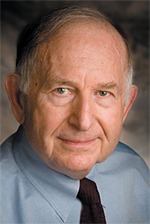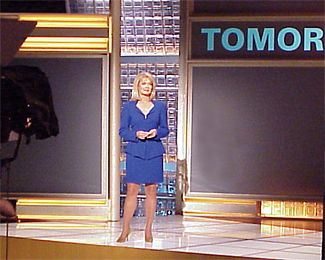Having Some Elliptical Spotlight Fun

Using ellipsoidal theatrical spotlights can be a lot of fun. Not usually considered a basic film-video fixture type, it can, however, be a very useful and entertaining member of the lighting toolkit when used in the film/TV camera world.
THEATER WORKHORSE
The number of ellipsoidal spotlights in theatrical applications is in the millions. Nearly all are fitted with an incandescent lamp under 1,000 watts. These are favored by theater lighting designers because of their ability to precisely define a lighted area with ease.
The lighted area can be much more defined than is possible with any other common fixture type. A fresnel lens fixture doesn't even come close. An additional plus is that it has the desired spectral characteristics of the incandescent source and the ability to dim.
In the theatrical setting we are lighting for the eye. The eye can accept an enormous range of brightness values and still function. For example, during a sunlight day we can see into the deep shadow areas as well as the objects that are in direct sunlight. It is this eye's ability to handle brightness extremes that has made the ellipsoidal spotlight so important to theater lighting designers.
It has the ability to tightly control the lighting area with limited light outside the beam. For example, in a typical stage setting where the stage floor is black, the ambient light from an ellipsoidal can be practically unseen, a great advantage to the designer to eliminate "unlighted" areas from the audience's view.
We can use this isolation characteristic to our advantage when lighting for the camera… and to great satisfaction.
THE FIXTURE
To review the principle of the fixture, notice Fig. 1. There is an aperture within the instrument fitted with shutters and an accessory slot. It is possible to obtain a focused image of the aperture at any plane selected by the user. This can be a circle if we image the open aperture or, with an iris in the slot, obtain a focused circle of lesser diameter. We can also place a stencil-like pattern in the accessory slot to project this image on a wall.
For many years these instruments have been used in television as a device to project a great range of images, not always to great effect, from radiator grills to cockeyed windows to cat's paws. It is, however, the use of the four shutters where the units can be really useful for more important tasks.
A rectangular, trapezoidal, or triangular lighting area can be easily obtained. Compare this easy task using our ellipsoidal spot with what we would require of our grip package, a rather complicated and space-hungry array of flags and grip arms.
This grip solution becomes inconvenient if mounted overhead. It becomes impossible to realize in a saturated overhead fixture configuration that is the norm in a multiple camera, multiple-set situation in television production.
The manner by which the ellipsoidal spotlight gathers the light from the lamp filament is quite unique and results in an efficient gathering of the lumens from the lamp source.
The great destroyer of all light-generating methods is heat. In many traditional units, for example, in fresnel spotlights, a spherical reflector mirrors the light emanating from the rear of the filament back to the filament to increase the amount of light directed towards the front of the unit. It works okay, but also heats the filament and, as a result, can decrease the lamp life.

Talent standing in fixed position downstage between two rear projection screens. In the ellipsoidal spotlight the reflector is elliptical in shape. If filament is placed at a focus point of the ellipse, the rays of light from this focus point pass through the second focus point of the ellipse, a basic property of an ellipse. This not only gathers more of the light that is off-axis that is lost in a spherical reflector, but does not heat the filament as much.
The development in the early 1930s of a theater lighting fixture using this principle is credited to Joseph Levy and Ed Kook and the nickname, "LEKO" a contraction of their last names, is in common use.
THE LEKO
Lekos come with various exchangeable lenses of different focal lengths, which are chosen depending upon the throw distance and the area to be covered. The very popular and affordable unit, the ETC Source 4 comes in (field) angles of 5, 10, 14, 19, 26, 36, 50, 70, and even, 90 degrees. Quite a range. The 5 degree is used for the longest throws. But more importantly for the purpose I'm going to suggest, there are two zoom lens configurations with variable beam angles of from 25–50 degrees and from 15–30 degrees that offer greater convenience and usability in the TV/film studio applications.
THE PAYOFF
The photo on p. 44 shows the talent standing in a fixed position slightly downstage and between two rear projection screens. The screens in the photo are unlighted to better show the result. To retain the contrast of the screen's images, it is important to have a minimum amount of spill from any light on the screen.
Because of the closeness of all the elements in this studio situation, the placement of the front light for the host is quite tricky, but is not an unusual production situation. The ellipsoidal is an ideal solution. In this case, notice that the spill light from the source is contained within reasonable limits even though the sharp edges of the lamp's lighted area has been softened by defocusing the lamp's image to mask the edge.

Fig. 1 Leko Optical Diagram Because there is no convenient means to adjust the intensity on a fixed-focus ellipsoidal unit, I propose using the zoom ellipsoidal unit. Assuming you selected the proper field-angle lens tube (always a challenge), the fixed-focus unit would require either a neutral density gel or wire screen to decrease the light. Screens are not supplied as an accessory to a theatrical unit. However, after positioning the zoom Leko, the field-angle zoom mechanism can be adjusted in a simple manner to act as an intensity control and to provide the exposure level desired. This adjustment would be made prior to adjusting the framing shutters. After adjusting the framing shutters, the image is softened by defocusing, probably by pulling the lens barrel towards the back of the unit or by using a 119 Rosco Roscolux Hamburg Frost. I think this is a clever solution to this very common dilemma.
ONE WARNING
There is one little pitfall that should be mentioned about using ellipsoidal spotlights and that is the lamp positioning adjustment. In order to perform in a proper manner, two adjustments are provided. One incrementally moves the lamp filament axially towards front or to back. The other control centers the lamp filament relative to center axis. This must be done carefully as this positioning has a significant effect on the unit's light output and field evenness.
It is possible to adjust to obtain very high light output with an unusable, uneven field. It is also possible to overshoot the ideal adjustment and obtain a flat field with little light outlet. A little practice will get you into the swing of things so that you find the proper compromise adjustment. Theatrical designers will tell you that they seek the "cosine" candlepower output, actually too "spotty" for our purposes. Don't look for a marking or detent anywhere on the unit that says "cosine."
FEEDBACK
I would be interested to get feedback from readers who try this use of this very theatrical unit. On the occasions where I have used this type of fixture to solve a spill problem, it was always rewarding and great fun.
Bill Klages would like to extend an invitation to all the lighting people out there to give him your thoughts atbillklages@roadrunner.com.
The professional video industry's #1 source for news, trends and product and tech information. Sign up below.
